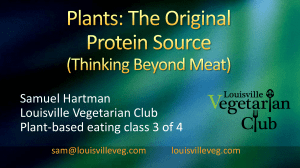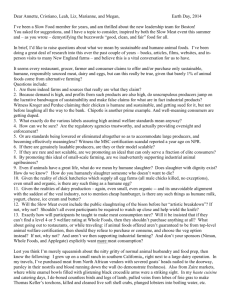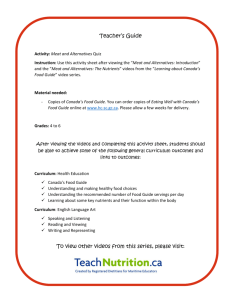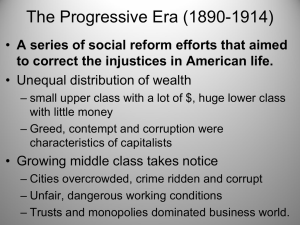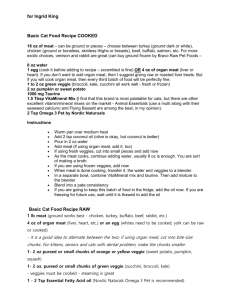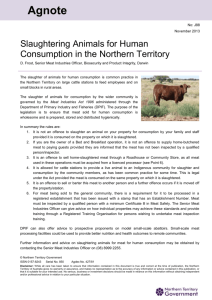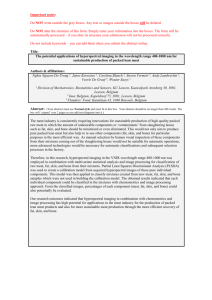Dr. Pat Brown powerpoint - World Preservation Foundation
advertisement
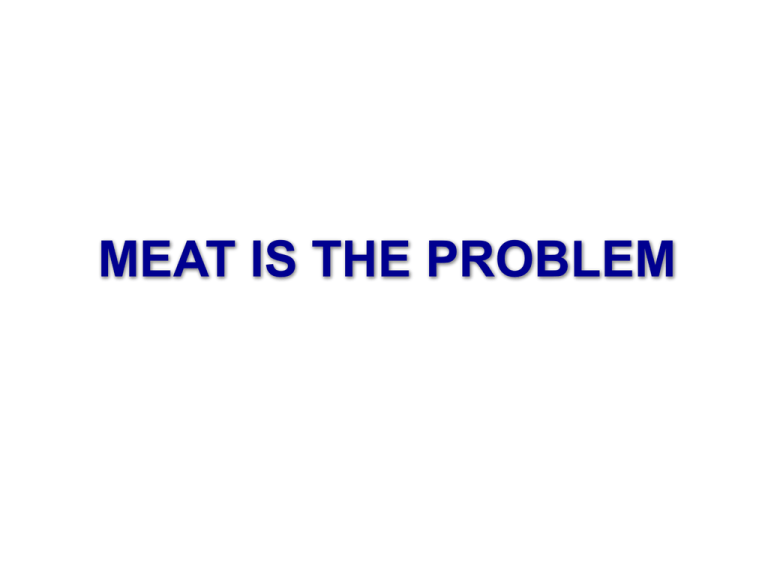
MEAT IS THE PROBLEM The REAL population bomb… Human population: 6.9 Billion Estimated total human biomass: 50 kg * 6.9 Billion = 345 million metric tons •Livestock account for about 20 percent of the total terrestrial animal biomass. •30 percent of the entire land surface of Earth is devoted to animal farming.. UN Food and Agriculture Organization, 2006 Land converted to pasture and rangeland Land converted for crop cultivation Most crops in the developed world are used to feed animals 156 billion metric tons of C released due to land-use conversion for agriculture, mostly for animal farming. (RA Houghton, 2003) About 9 billion metric tons of C were released by burning fossil fuels this year (US Dept of Energy) The historical land-use change is the GHG equivalent to 17 years worth of fossil fuel emissions. Corollary: A tremendous opportunity for rapid mitigation of GHG emissions - Reversing historic losses of forest, savannah, scrubland and prairie would yield immediate benefits by turning CO2 back into biomass. Seasonal fluctuations -sharp decreases every year but not quite enough to match the increases LAND USE – REPLACING MEAT WITH PLANT-DERIVED ALTERNATIVES WOULD RECOVER THE HUGE OPPORTUNITY COST OF ANIMAL FARMING Current world production of soybeans, corn, wheat and rice contains more protein and calories than the human population consumes annually (130% of the protein consumption and more than 200% of dietary requirement for protein). Replacing meat with plant-derived sources of protein could reduce the land area required to feed the human population by more than 80% and recover about 25% of the entire above water surface of the Earth for restoration or solar energy capture. Absolutely no requirement for animal products in a healthy, nutritious diet Economic benefits: No change in diet Eliminate animal foods •Eliminating animal farming would reduce the cost of meeting greenhouse gas stabilization target by more than 80% (that’s tens of trillions of dollars…) compared to alternative strategies. Smaller reductions would produce correspondingly smaller but still significant savings. (Stehfest, et al. Climatic Change 2009) Can we realistically hope to reduce consumption of meat and dairy products? Smoking rate in the US has decreased more than 50% in 40 year In California rate now less than 13% (Down 40% in last decade alone). Economic incentives can work Plants can provide the nutritional equivalent of meat at less than 5% the cost The most popular meat in the US -ground beef sales $30B/year -wholesale price ~$1.50/lb -nutritionally matched soy-grain combos ~ $0.07 Demand for meat, dairy and fast food is highly sensitive to price. => Demand will shift to alternatives that satisfy the same need at a cheaper prices. Adjust policy to make the cost of meat and milk reflect the true cost that either we or our children will have to pay to fix the damage that animal farming does. This is a huge opportunity for investors and entrepreneurs In 1965, more than 40% of adults in the US were smokers. Today, Currently available, inexpensive plant-based alternatives do a poor job of mimicking the real thing (and aren’t actually so cheap). $1.50 (wholesale) $1.50/lb-ground beef eq (wholesale) Available plant-based alternatives that more successfully (but still inadequately) mimic the real thing are MORE expensive than meat and marketed to a small niche market. $8-10/lb $1.50 (wholesale) Business Opportunity There is a huge window of opportunity for investors and entrepreneurial food producers to develop mass-marketable, affordable, nutritious plant-based foods products that can compete successfully with established meat and dairy products based on their value and taste. Potential scale: Just 1% of the wholesale market for meat and dairy ingredients in the US alone is $1.5 billion/yr company. McDonalds alone had $23B in revenue and >$4B in profit last year.




